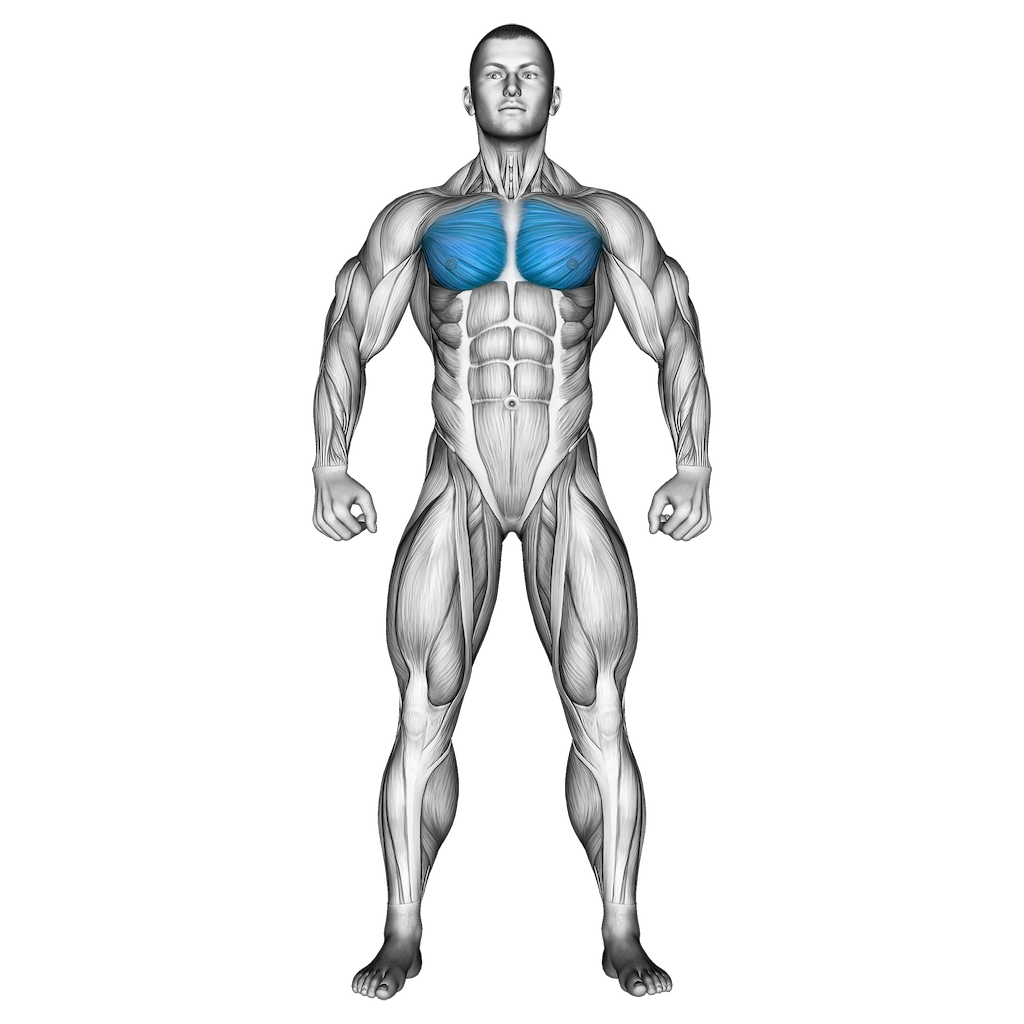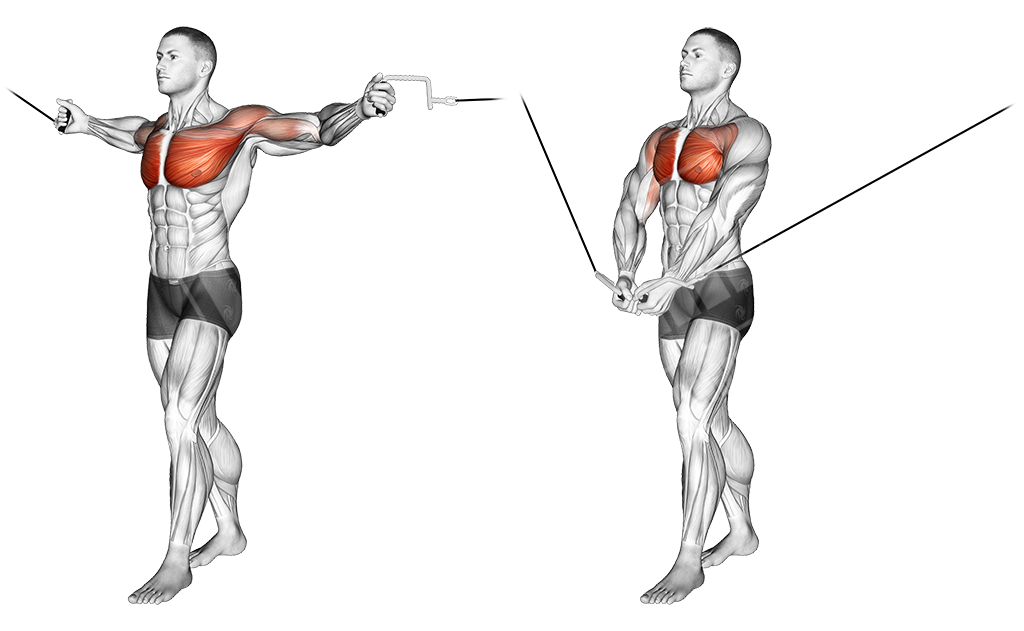
Are you looking for an effective way to build a stronger, more toned chest? You’ve come to the right place! Building muscle is often the primary goal of training your upper chest. But knowing which exercises are the most beneficial can be tricky – that’s why we’re here.
In this blog post, we’ll look at five of the best Upper Chest Exercises and provide tips on maximizing their potential for achieving those sought-after results. So if you’re ready to start, keep reading and learn all about creating an effective upper chest workout routine!
Introducing Upper Chest Exercises
The first step to building lean, toned muscles is understanding how the upper chest works. The main muscles of the upper chest are the pectoralis major and minor. These muscles play an important role in maintaining posture, generating force during pushing movements, and stabilizing shoulder joints when lifting weights.
Understanding the Anatomy of the Upper Chest
The upper chest, primarily composed of the clavicular head of the pectoralis major, is a distinct muscle group that contributes enormously to the overall aesthetics of the chest. The pectoralis minor, situated beneath the major, plays a supporting role.
These muscles work together to allow for many movements, such as pushing and pulling, and maintain shoulder joint stability. Understanding this anatomy is crucial as it aids in executing exercises specifically targeting these muscles.
By focusing on upper chest exercises, you can work to develop this specific area, leading to a more defined, muscular appearance. Proper form, technique, and consistent training are key to stimulating muscle growth and achieving fitness goals.
Why Work Your Upper Chest?
Working the upper chest is crucial for several reasons. Firstly, a well-developed upper chest enhances the overall aesthetic appeal of your physique. It can add depth and definition to your chest, contributing to a more balanced and muscular appearance. This particularly benefits bodybuilders and athletes, for whom physical symmetry is highly desirable.
Secondly, strengthening the upper chest is not just about aesthetics. It plays a vital role in improving functional strength and stability. The upper chest muscles are engaged in various daily activities, from pushing doors open to lifting heavy objects. By strengthening these muscles, you can improve your performance in these tasks, making them easier and less strenuous.
Additionally, focusing on upper chest exercises can aid in correcting postural issues. Many people suffer from rounded shoulders due to prolonged periods of sitting, often in front of a computer. This can lead to an imbalance in the chest muscles, with the lower chest dominating. By emphasizing upper chest exercises, you can work towards correcting this imbalance, thereby improving posture and reducing the risk of shoulder and back pain.
Finally, working the upper chest can positively impact your athletic performance. Many sports and physical activities, such as swimming, boxing, and tennis, require strong chest muscles. Enhanced upper chest strength can provide the power necessary for these movements, improving your performance and reducing the risk of injuries. Therefore, incorporating upper chest exercises into your workout routine is smart for aesthetic and functional reasons.
Best Upper Chest Exercises
Now that we’ve discussed the anatomy of the upper chest and why it’s important to work on this area, let’s look at some of the best exercises for developing the upper chest muscles. Here are five top picks:
Incline Bench Press

The Incline Bench Press is one of the most effective upper chest exercises to incorporate into your workout routine. The exercise targets the clavicular head of the pectoralis major, thus helping to build and define the upper portion of the chest. By adjusting the angle of the bench, you can increase the emphasis on the upper chest muscles. Typically, an angle of 30 to 45 degrees is recommended to target the upper chest best.
To perform this exercise, lie shoulder-width apart on an incline bench with a dumbbell in each hand. Press the dumbbells until your arms extend almost fully, ensuring your hands are directly above your shoulders. Pause briefly at the top before lowering the weights to the starting position. Maintaining control throughout the movement is crucial, avoiding the urge to drop the weights too quickly during the lowering phase.
This exercise can be performed with barbells or dumbbells, depending on your preferences and availability. Dumbbells provide a greater range of motion and work each side of the body independently, which can help correct any muscle imbalances. On the other hand, barbells allow you to lift heavier loads, which can benefit muscle growth.
Incline Dumbbell Press

The Incline Dumbbell Press is another effective upper chest exercise that targets the pectoralis major’s clavicular head. To execute this exercise, position yourself on an incline bench with a dumbbell in each hand. Start with the dumbbells at shoulder level, palms facing away from you. Press the dumbbells upwards until your arms are almost fully extended, keeping the weights directly above your shoulders.
After a brief pause at the top, lower the dumbbells back to the initial position in a controlled manner. This exercise enhances upper chest strength and promotes muscle balance by working independently on each side of the body. Whether you’re an experienced lifter or a beginner, the Incline Dumbbell Press is an excellent addition to your upper chest workout regimen.
Bench Press

The Bench Press is a classic compound exercise that targets your chest, triceps, and shoulders. While it’s often associated with lower chest development, a proper bench press can also be a powerful tool for your upper chest when utilized with an incline. The exercise starts by lying on a flat bench (inclined for upper chest focus) with your feet flat on the floor.
Grasp the barbell with an overhand grip, hands slightly wider than shoulder-width apart. From this position, lower the barbell towards your chest, keeping your elbows at a 90-degree angle. Once the barbell lightly touches your chest, push it back upwards, extending your arms fully without locking the elbows.
Throughout the exercise, keep a neutral spine and avoid excessive back arching. Is important. The bench press can help you build significant upper body strength and size, contributing greatly to a well-defined, muscular upper chest.
Close-Grip Bench Press

The Close-Grip Bench Press is a subtle variation of the traditional bench press, predominantly targeting the triceps and the central chest. However, with slight modifications, it can also be an effective exercise for the upper chest. Like the bench press, start lying on a bench with your feet flat on the floor.
The key difference comes in the grip—your hands should be closer together, roughly shoulder-width apart on the barbell. Lower the barbell towards your chest, maintaining control throughout the movement and keeping your elbows tight to your body.
Press it upwards as the barbell reaches the chest, ensuring your arms are fully extended but not locked. Incorporating an incline into this exercise can further emphasize the upper chest muscles.
Overhead Press
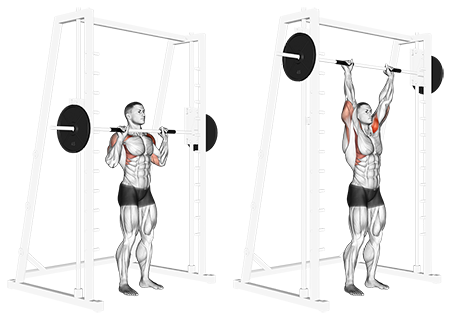
The Overhead Press, also known as the Military Press, is a fantastic exercise that primarily targets the shoulders but can also engage the upper chest, especially at different angles. To execute this exercise, stand upright with your feet shoulder-width apart and grip a barbell at just wider than shoulder width. The bar should start at about collarbone level.
Keeping your core tight and your back straight, press the barbell upwards until your arms are fully extended overhead. Briefly pause at the top before lowering the bar back to the starting position in a controlled manner.
While the Overhead Press does not target the upper chest as directly as some other exercises mentioned, it still significantly promotes upper body strength and stability. It can also provide deeper chest engagement when performed on an inclined bench. The Overhead Press adds variety to your workout, challenging your muscles differently and promoting a more balanced, functional strength.
Low to High Cable Chest Fly

The Low to High Cable Chest Fly is an excellent exercise targeting the upper chest muscles. BPerformingthe movement from a low to high angle puts considerable emphasis on the clavicular head of the pectoralis major, helping to build and define the upper chest. To perform this exercise, begin by standing in the middle of a cable machine, grasping the handles of the lower pulleys in each hand.
Take a step forward for stability, maintaining a slight knee bend. With your arms extended and slightly bent at the elbows, pull the cables from the lower position up and inwards, following an arc-like path until your hands meet at chest height. Briefly pause at the top of the movement and squeeze your chest muscles, then slowly return the handles along the same path back to the starting position.
This exercise requires control to avoid injury and maximize its effectiveness. In addition to the upper chest focus, the Low to High Cable Chest Fly also works the shoulders and arms, making it a comprehensive upper body workout. This exercise offers a unique movement pattern that can add variety and help overcome a plateau in your upper chest development.
Dumbbell Chest Fly
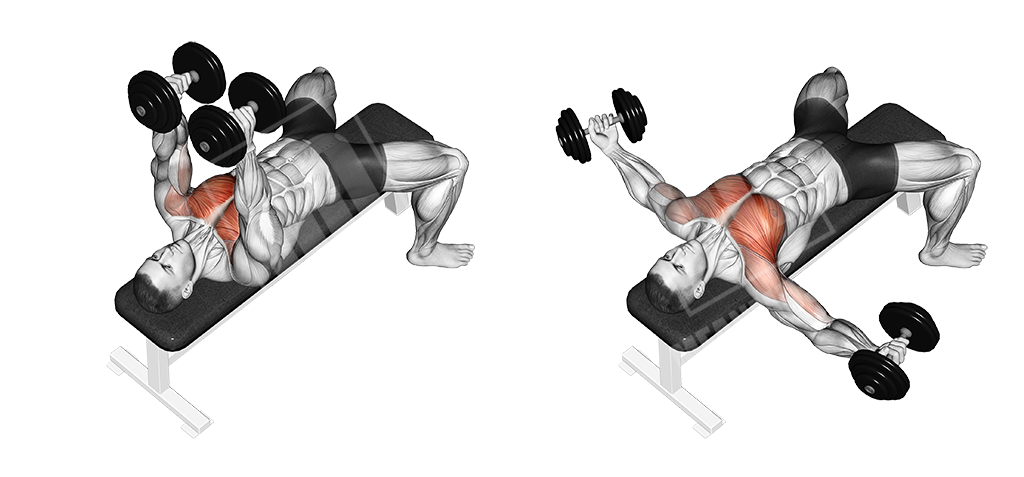
The Dumbbell Chest Fly is another top-tier exercise for targeting the upper chest. It is an isolation movement that calls into play the pectoralis major and, to a lesser extent, the anterior deltoids. To perform the Dumbbell Chest Fly, lie on a bench with an incline of about 30 to 45 degrees. Start by holding a dumbbell in each hand directly above your chest, with the palms facing each other and a slight bend at the elbows.
Then, lower the weights in a wide arc until they are level with your chest, keeping the slight bend in your elbows constant throughout the movement. After reaching this point, reverse the motion to bring the dumbbells back to the starting position. This exercise is all about control and form, not the weight used. It is crucial to avoid using momentum or allowing the dumbbells to drop rapidly, as this can lead to injury.
The Dumbbell Chest Fly is an excellent exercise for a more pronounced and well-defined upper chest. to incorporate into your workout routine
Machine Chest Fly
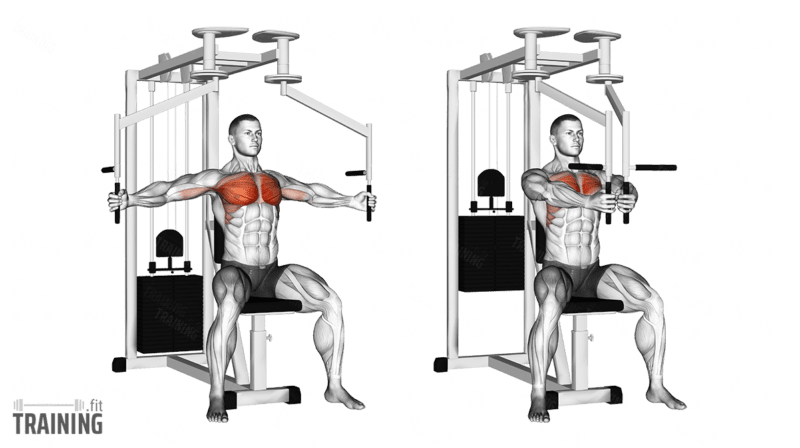
The Machine Chest Fly, often called the Pec Deck Machine, is a highly effective exercise designed to isolate the chest muscles, specifically the pectoralis major. It’s particularly beneficial for the upper chest when performed on an incline. Adjust the machine to match your body size, ensuring your back is flat against the bench and your feet are firmly planted on the ground.
Grasp the handles or arm pads, keeping your elbows slightly bent and aligned with your chest. Slowly bring the handles or arm pads together before you, squeezing your chest muscles at the movement’s peak. Pause briefly, then control the handles or arm pads as they return to the starting position, ensuring the weight stack does not touch between repetitions.
This exercise encourages a full range of motion, which is key to maximizing muscle development in the upper chest. Remember, as with all exercises, to choose a weight that allows you to maintain proper form throughout the exercise. The Machine Chest Fly is a worthy addition to any upper chest workout routine, catering to both beginners for its ease of use and seasoned gym-goers for its effectiveness.
Dumbbell Front Raise
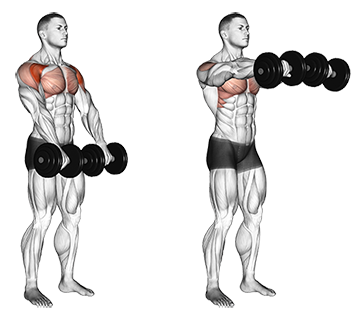
Although primarily targeting the shoulders, the dumbbell Front Raise is an effective exercise that indirectly engages the upper chest muscles. Begin the exercise by standing upright with a dumbbell in each hand, your palms facing towards your body, and the weights resting on your thighs. Keeping a slight bend in your elbows and your back straight, raise the dumbbells in front of you until they reach shoulder height. Maintain control throughout the motion, ensuring that your shoulders, not your arms, are doing the work. Then slowly lower the dumbbells back to the starting position.
The Dumbbell Front Raise can provide a broader, more complete muscular development by varying the angles at which the muscles are worked, hence its inclusion in upper chest workouts. As with all weightlifting exercises, it’s crucial to use a weight that challenges you, but not at the expense of maintaining proper form throughout each repetition. This exercise is ideal for any fitness level and an excellent addition to your upper chest training regimen.
Decline Push-Up

The Decline Push-Up is a variation of the traditional push-up that emphasizes the upper chest muscles. By elevating your feet above the level of your hands, the angle of the push-up is altered, shifting the focus to the clavicular head of the pectoralis major.
To perform this exercise, position yourself in a traditional push-up stance, then elevate your feet onto a stable, raised platform such as a bench or step. Keep your hands shoulder-width apart, palms flat on the floor. Lower your body toward the ground, maintaining a straight line from your head to your heels, and then push back up to the starting position.
Engage your core throughout the movement to maintain body alignment and stability. You should feel your chest, shoulders, and triceps working as you perform the push-up. The Decline Push-Up is a functional exercise that activates the upper chest band and strengthens multiple muscle groups.
Its inclusion in your workout regimen can contribute to a more rounded upper body strength and muscularity. Remember to perform each rep with control and to adjust the height of your feet to vary the intensity of the exercise. Upper chest muscle fibers work to increase strength, size.
FAQs
What are some upper chest exercises?
Upper chest exercises include the Low to High Cable Chest Fly, Dumbbell Chest Fly, Machine Chest Fly, Dumbbell Front Raise, and Decline Push-Up. Each exercise focuses on different chest muscles and offers a unique movement pattern to help promote overall upper-body strength and muscularity. It is important to remember to keep good form and use an appropriate weight when performing any of these exercises.
What muscle does the Decline Push-Up target?
The Decline Push-Up primarily targets the clavicular head of the pectoralis major (upper chest). It is an effective exercise for strengthening the upper body, working multiple muscles throughout the body, such as the chest, shoulders, triceps, and core.
How can I maximize Muscle Development?
Focusing on proper form and control during each exercise is important to maximize muscle development. Additionally, it is important to vary your exercises periodically to effectively target different muscles from different angles.
What is the benefit of using a Machine Chest Fly?
The Machine Chest Fly is an effective exercise for isolating the chest muscles, specifically the pectoralis major. It helps to engage the upper chest when performed on an incline and encourages a full range of motion, which is key to maximizing muscle development in this area.
What is the proper form for a Dumbbell Front Raise?
The proper form for a Dumbbell Front Raise is to stand upright with dumbbells in each hand, palms facing toward your body, and the weights resting on your thighs. Keeping a slight bend in your elbows and your back straight, raise the dumbbells in front of you until they reach shoulder height. Slowly lower the dumbbells back to the starting position, maintaining control throughout the motion by ensuring that your shoulders, not your arms, are doing the work.
Conclusion
Upper chest exercises are an important part of any strength training regimen. IExercisessuch as the Low to High CChestChest Fly, Dumbbell Chest Fly, Machine Chest Fly, Dumbbell Front Raise, and Decline Push-Up can help strengthen and develop the upper chest muscles for a more defined overall appearance. Consider incorporating these into your workout routine to maximize muscle development and reap the benefits of a strong upper pecs.

